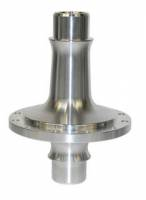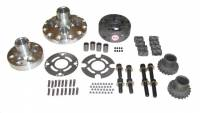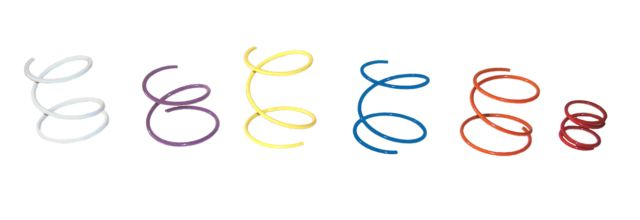Getting to the front often start with a good rear end. Today, there are many options and choosing the right rear end type for your team is the goal.
To help your team choose the correct rear end type for your car, I interviewed Frank Loverock of Quick Change Exchange. Frank manufactures ratcheting rear ends and differentiating rear ends and he has provided a wealth of information for this article. In addition, Randy Larsen of DPI added thoughts relating to the benefits of differentiating rear ends as well as his thoughts on the different styles of rear ends and other tips.
Rear Ends – A Simple Overview
A spool is a simple chunk of billet aluminum with axle splines. The spool is very durable and simple. Since the axles are solidly connected, a spool requires stagger to deal with the LR tire following the shorter radius at the inside of the corner as compared to the RR. When you push a car through the pits you see the LR tire skip as it catches up with the larger radius of the RR tire.
The Locker (Ratchet)
 The Locker (Ratchet) allows the wheels to unhook one tooth at a time on corner entry. The “ratcheting” mechanics allow the LR to roll in the corner in conjunction with the RR helping to overcome the negative effects of stagger on corner entry. As soon as any amount of throttle pressure is applied, the locker (ratchet) locks up and performs like a spool. Both axles are locked together and when the power is put down a ratchet and a spool work the same.
The Locker (Ratchet) allows the wheels to unhook one tooth at a time on corner entry. The “ratcheting” mechanics allow the LR to roll in the corner in conjunction with the RR helping to overcome the negative effects of stagger on corner entry. As soon as any amount of throttle pressure is applied, the locker (ratchet) locks up and performs like a spool. Both axles are locked together and when the power is put down a ratchet and a spool work the same.
Differentials utilize a series of gears that apply the power to each rear tire individually
 Differentials utilize a series of gears that apply the power to each rear tire individually. Less stagger is required and if your stagger changes the differentiating action works to keep the handling characteristics of your car the same throughout the race. A differentiating rear end has moving parts that require regular maintenance. Quality gear oil is needed and performance can be changed based on the type of oil used. Coolers are highly recommended when you run a differential style rear end unit.
Differentials utilize a series of gears that apply the power to each rear tire individually. Less stagger is required and if your stagger changes the differentiating action works to keep the handling characteristics of your car the same throughout the race. A differentiating rear end has moving parts that require regular maintenance. Quality gear oil is needed and performance can be changed based on the type of oil used. Coolers are highly recommended when you run a differential style rear end unit.
Differentials apply power to each wheel independently and the need for stagger is reduced. The axles are not solidly connected together and internal gears apply power to each tire separately. The result is a rear end that compensates for stagger changes. The car is more consistent and self adjusts for changing corner conditions.
Racing differentials feature an aluminum housing that are lightweight. Manufactures are always discovering new ways to improve performance while producing lighter weight parts. Unit’s of today do more and weigh less due to design improvements and superior machining techniques.
Q: As compared to a spool – why is a locker a good choice?
Frank Loverock: The benefit of a locker is improved corner entry. As you roll into the corner, without any throttle pressure, the car enters the corner and the effects of stagger are basically eliminated. Both tires roll in equally as specially designed springs control the ratcheting action. At entry, the LR is connected to the driveline and the right wheel ratchets forward creating an entry without effective stagger. The car never freewheels, either one or both rear tires are connected to the driveline. The instant you push the throttle the ratchet locks up and you drive both rear tires 100% just like a spool. A locker (ratchet) is a spool 90% of the time so it is a myth that you can run less stagger.
Randy Larsen: A locker can help a car into the turn and reduce an entry push. The rear tires ratchet in a controlled fashion for a more stable entry. Since LR isn’t dragging entering the turn, drivers can drive in deeper. A locker becomes a spool as soon as the driver hits the gas so stagger settings are critical. Under power, the locker acts just like a spool so your tire guy needs to make sure that the stagger remains perfect throughout the race. Any change in stagger is going to be felt and loss of stagger often will create a nasty center push.
Frank Loverock: The benefit of a locker is improved corner entry. As you roll into the corner, without any throttle pressure, the car enters the corner and the effects of stagger are basically eliminated. Both tires roll in equally as specially designed springs control the ratcheting action. At entry, the LR is connected to the driveline and the right wheel ratchets forward creating an entry without effective stagger. The car never freewheels, either one or both rear tires are connected to the driveline. The instant you push the throttle the ratchet locks up and you drive both rear tires 100% just like a spool. A locker (ratchet) is a spool 90% of the time so it is a myth that you can run less stagger.
Randy Larsen: A locker can help a car into the turn and reduce an entry push. The rear tires ratchet in a controlled fashion for a more stable entry. Since LR isn’t dragging entering the turn, drivers can drive in deeper. A locker becomes a spool as soon as the driver hits the gas so stagger settings are critical. Under power, the locker acts just like a spool so your tire guy needs to make sure that the stagger remains perfect throughout the race. Any change in stagger is going to be felt and loss of stagger often will create a nasty center push.
Q: As compared to a spool – why is a differentiating rear end a good choice?
Frank Loverock: On a circle track car, the RR must travel faster and further than the LR due to the larger corner arc on the outside of the track as compared to the inside. The differentiating action turns the LR at a slower rate helping the car to turn.
Differentiating rear ends offer great advantages but come with significant maintenance so a trade off is made. The benefit is a car that really turns. The rear end may drive the LR 49% and the RR 51% and the unit is always differentiating applying power as needed to the wheel that needs it most. Differentials never drive the LR and RR equally but rather compensate for the ever changing position on the track. In other words, differentials are always driving the appropriate wheel faster than the other eliminating the dragging of a tire down the straight away. The faster turning of the outside wheel gets your car through the center with less dependence on stagger. Spools and lockers drag one tire if you are running even a small amount of stagger.
Randy Larsen: A differential gets you through the center allowing the car to turn freely setting you up for a straight and powerful exit launch. The differential action allows you to run the low groove one lap and the high groove the next as the gear mechanism compensates for the change in corner radius. If your stagger changes – the differential will make up the difference so you car stays fast the entire race.
Since the differential gets you through the center, you can adjust your set up for a tight launch off the turn. The differential gives you more chassis setup options than a standard spool and the driver feel through the center is vastly improved. When your stagger changes a spool driven setup is negatively affected. The torque sensing action of differential units allows the car to roll freely through the center and compensates for changing stagger.
Q: What improvements in design and quality have been added to rear ends?
Frank Loverock: Superior machining operations create parts that mate together precisely for smooth long lasting operation. Better materials coupled with sophisticated heat treating processes create unparalleled longevity and performance. Rear end units last longer and work better through exploitation of modern science. Knowledge from the past is applied to what we build today. Historical influence is partnered with advanced modern day processes creating improved product at fair pricing.
Randy Larsen: In racing, heat is nearly always the enemy. New manufacturing processes have allowed components to be light where needed and designers can pinpoint the need for mass at critical areas. Heat treating and CAD software have allowed differentiating rear ends to be optimized as compared to past designs. The optimization results in consistency. Units manufactured today limit and compensate for heat expansion efficiently resulting in enhanced performance.
Q: What rear end types do you recommend to experienced racers?
Frank Loverock: For experienced teams, a locker or a differentiating rear end is a good choice. It comes down to driver feel. Experienced teams are better suited to handle the added maintenance and often have larger budgets. The benefits of advanced rear ends, provides choices for experienced chassis gurus. With better feel, drivers can often get more speed by utilizing a rear end that matches their style, track and set up.
Q: What rear end types do you recommend for beginning racers?
Frank Loverock: For beginning racers I think a spool or maybe a locker is best. It all depends what the new driver wants to get out of their career. If they hope to move up to the top NASCAR divisions then gaining a feel for a locker becomes more important. All the top NASCAR series require lockers so gaining experience is a factor. Lockers require maintenance but the rebuild cost and time is manageable.
I strongly believe that a beginner should keep things simple so the spool is a good choice. As beginners gain experience and understanding grows, then experimenting will help their learning curve. Trying new things will help beginning teams to learn what different adjustments can accomplish. Starting from a simple proven baseline speeds the learning curve. As knowledge increases and drivers become more confident, then replacing the spool with a locker or differential creates a situation where teams can learn and feel the benefits from trying out new ideas.
Q: Coolers, Oil & Maintenance for lockers & differentials?
Frank Loverock: A rear end cooler is highly recommended and the best quality gear oils add to performance. Our group has designed synthetic oils that are specifically engineered for the friction created by the differentiating action. The test time to create exceptional gear oil is unbelievable and regardless of the gear oil you choose, quality is a must.
Randy Larsen: Gear oil choice for differentiating rear ends is an area where spending more is always the best choice. Inexpensive gear oils translate to worn out hardware. We recommend top quality gear oil such as Joe Gibbs. We recommend coolers as reducing heat increases longevity and consistency.
Both Frank and Randy recommend servicing lockers & differentials twice a year based on 25 races under 100 laps. A once a year rebuild “can” be okay. But, stretching service intervals can result in diminished performance. Personally, I would go with twice a year, as a minimum, based on the 25-100 lap race schedule. A locker requires less maintenance as compared to a differential. Ensuring that locker springs hold their designed rate is a must.
Q: How has the use of rear end units changed?
Frank Loverock: Experience has allowed us to manufacture 6 different springs’ rates for locker units. Stronger spring rates give the car a tighter feeling on corner entry. Lesser rates free the car up. Individual drivers often like different feels so over time the need for multiple spring rate options have evolved. Manufacturing processes have improved allowing for all rear end units to create more corner speed. Spring technology allows for ratchets to be custom tailored for specific track conditions or driver styles.
Locker springs are manufactured in a variety of rates to control the ratcheting action for the perfect driver feel on corner entry. A stiffer spring creates a tighter feel on entry and correspondingly a lighter rate spring creates a more free feel.
Randy Larsen: Tolerances control has made giant leaps forward. Differentiating rear ends perform better and last longer. As the manufacturing techniques have improved, engineers can find more speed with components that mate up more efficiently. As the science improves, doors of creativity open. Engineers can take advantage of creative ideas as they can count on sound manufacturing processes that produce components that perform every week.
Q: What other tips relating to rear ends would be important for our readers?
Randy Larsen: Proper venting is paramount to rear end performance. 1/2” hose and a minimum of 3/8” NPT fittings will allow sufficient air volume and rear end breathing. Small hose can cause pressure build up and unwanted problems. Be sure to route your vent line so that oil can drain freely. Kinks and dips in the line will cause oil to pool up preventing proper venting. The vent should be at the highest point possible above the housing. The hose should be routed as straight as possible to avoid areas in the hose where fluid can pool up.
Frank Loverock: We are constantly developing technology and lighter weight differentials are the result. Differentials differ from lockers as they are free from locking and unlocking.
The differential allows you to run less stagger, about half as much as a spool, depending on the track. Differentials are very forgiving in relation to stagger changes as the gear mechanism is constantly adjusting to the current condition resulting in handling characteristics that stay the same throughout the race.
Jeff Butcher: All rear end types offer positive choices. The simplicity of a spool is very often fast, inexpensive and maintenance free. Heat is less of an issue and a rear end cooler is optional at many tracks.
The locker creates stable corner entry. Coolers are needed and correct locker springs will speed your car up. You sign up for maintenance but less is required than a differential.
The differential can do many things to add to speed. In exchange for the stagger compensating differential action, heat is created and since there are more mechanical parts – wear and maintenance need to be considered.
In the end, all three types consistently win races. It is not a question of right and wrong. Choosing the correct rear end is specific to the needs of each team and the goals that they have. My teams have won plenty of races with a spool and if you are on a tight budget the simplicity becomes more important. It was fun to win with the free entry of a locker which is often a great choice. At other times the differential willpower you to the front and that great feel in the center is something that drivers always enjoy. Teams that choose rear ends based on their own needs are making the “right” choice. In racing, bolting in speed is a myth. Having a nice rear end is always a good thing regardless of the type you like to run with.

